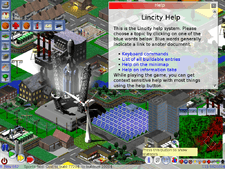City-building game
A city-building game, or town-building game, is a genre of simulation video game where players act as the overall planner and leader of a city or town, looking down on it from above, and being responsible for its growth and management strategy. Players choose building placement and city management features such as salaries and work priorities, and the city develops accordingly.

 |
| Part of a series on: |
| Simulation video games |
|---|
|
City-building games such as SimCity, Cities XXL or Cities: Skylines are considered a type of construction and management simulation.[1]
History
The city-building game genre was established in 1989 with SimCity, which emphasized continuous building rather than a set victory condition.[2] Players followed personal preferences in design and growth. Indicators of success were maintaining positive budget balance and citizen satisfaction. Subsequent SimCity titles such as SimCity 4 soon followed when high sales of the game demonstrated its popularity.
The first sim game, Utopia (1982) developed for the Mattel Intellivision console system, covered many of these same elements, but was limited by the primitive screen resolutions of its era. Unlike the thousands of individual spaces possible a few years later in SimCity, each island in Utopia held only 29 "buildable" spaces for schools, factories and other constructions. The player's score was based on the well-being of his people.
A second boost in genre popularity came in 1993 with the release of Caesar, a game which modeled cities in ancient Rome, replacing electricity and mass transit with aqueducts and roads. Subsequent titles in the City Building Series followed, all modeling cities in past civilizations.
The Dungeons & Dragons PC game Stronghold appeared in 1993, and was advertised as "SimCity meets D&D in 3D". Elves, humans and dwarves each built neighborhoods with unique architecture within the player's town. The title also had elements of real-time strategy games when enemies attacked the city, and the line between city-building and RTS games has often been blurred with this kind of hybrid title. True 3D graphics were not yet possible at that time, so the advertised 3D was actually a clever use of 2D graphics (an isometric projection) with mathematically generated terrain and overlaid bitmaps and sprites.
The Anno series started in 1998 and established a high level of detail in graphics as well as an intense economy simulation and a distinct gameplay.
SimCity 4, released in 2003, was praised as a standard-setter of the genre and still widely regarded as the best game in the genre, even a decade after its release,[3] but others suggest that the game has too steep of a learning curve and was too complex for a casual player.[2] Subsequent games in the series attempted to remedy this, such as SimCity Societies (2007), which did not further deepen the gameplay along the line of city simulation but incorporates different gameplay elements such as social management.[2] The changes to the formula polarized critics and its fan base alike. The reboot, SimCity, attempted to bring the franchise back to its roots but was panned by critics and traditional fans for its forced online requirements, bugs in simulation, missing promised features and restrictions on city size. The waning dominance of the SimCity franchise in the genre has caused several other companies to release similarly-themed games, like Cities XL (2009) and the commercially successful Cities: Skylines (2015).[2]
With the rise of social gaming, mobile gaming, freemium and micropayment model in the 2010s, there has been a surge of casual city-building games with different mechanisms like time-based "produce and upgrade" feature, including CityVille, SimCity Buildit, and City Island. Despite the fact that most traditional followers of the genre do not like these games,[4] they have gained greater success around the world than prior city building games.[5]
See also
- List of open source city building games
- Government simulation game
- Simulation game
References
Notes
- Rollings, Andrew; Ernest Adams (2003). Andrew Rollings and Ernest Adams on Game Design. New Riders Publishing. pp. 417–441. ISBN 1-59273-001-9.
- Richard Moss (October 11, 2015). "From SimCity to, well, SimCity: The history of city-building games". Ars Technica.
- Matt Smith (September 20, 2012). "5 Reasons To Go Back To SimCity 4 [Opinion]". makeuseof.
- Stephen Totilo (December 26, 2014). "SimCity Purists Are Understandably Upset About The Newest SimCity". Kotaku.
- Tasos Lazarides (June 8, 2015). "EA Mobile Claims that 'SimCity BuildIt' is Now The Most-Played 'SimCity' Game Ever". TouchArcade.
Further reading
- Conte P.-A.: "City builders: vis ta ville!", air le mag, n° 37, March 2013, pp. 33–35.